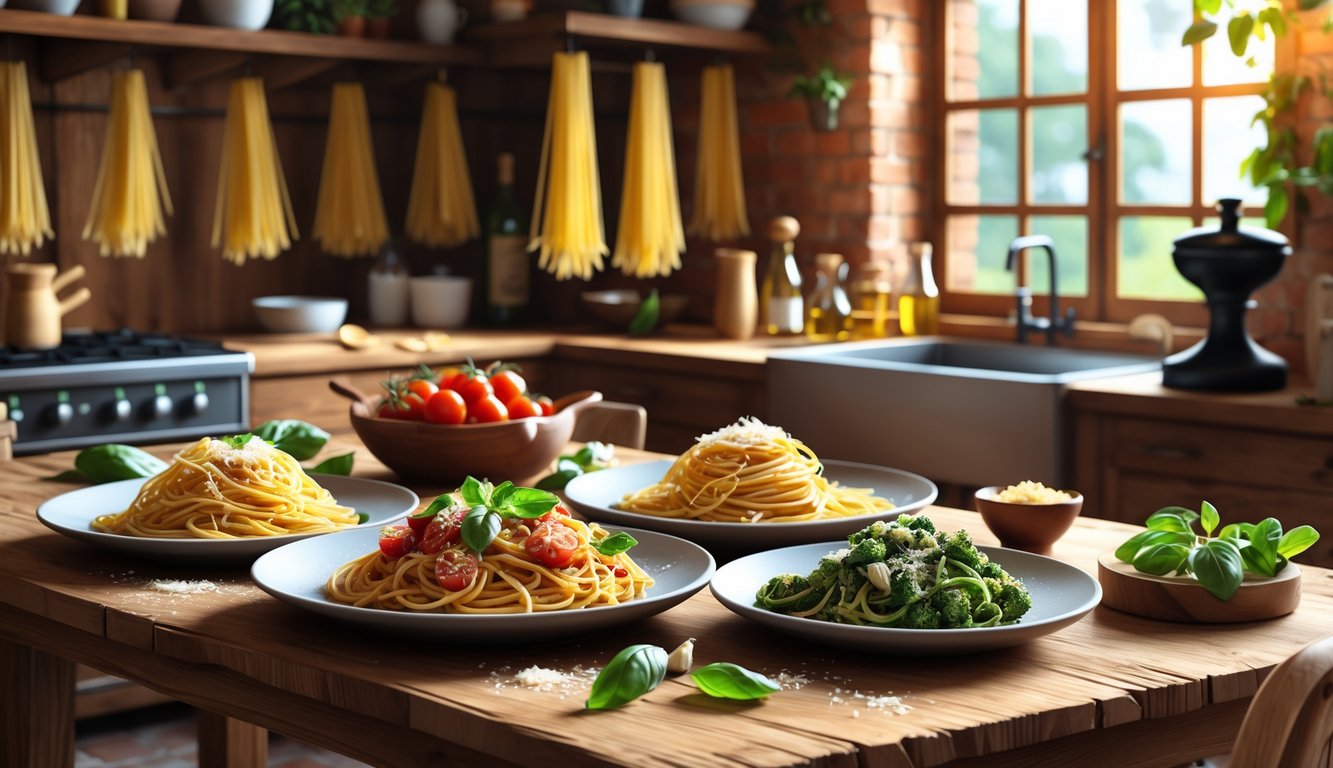
Picture this: I’m in some Milan café, jet-lagged and caffeinated, and someone mutters “chicken Alfredo.” Honestly, I think Italians would rather eat their own shoes. I mean, you ever stand outside a so-called “Italian” place abroad and just stare at the menu like, is this a prank? Fettuccine Alfredo drowning in cream, random chicken tossed on spaghetti, garlic so heavy you could repel vampires for a week. Wild, right? Most of these “classic” pasta dishes? Italians just skip them when they’re outside Italy—because, let’s be real, they’re not Italian at all and taste nothing like what’s on a real trattoria table. Ask literally any Roman nonna or Gennaro Contaldo: butter and cheese, fine; a garlic avalanche or a gallon of cream, not a chance. It’s as predictable as that 9-euro cappuccino at the airport.
I still can’t get over ravioli stuffed with chicken. Who started that? Is it a dare? Because actual Italian ravioli is all about spinach, ricotta, veal, pork—never chicken. That’s just some American chain fever dream. And the Alfredo thing? Creamy Alfredo is basically an urban legend in Italy. The real deal? Fettuccine al burro: just butter, Parm, done. No drama, no dairy explosion. Sometimes I wonder if “global Italian food” is a running joke for locals, like the endless breadbasket at American restaurants.
And when I quiz chefs about “authenticity” and why they don’t do those overloaded pastas—extra spice, weird toppings, cheese mountains—they just roll their eyes. It’s all about simplicity, fresh stuff, end of story. Ettore (some chef I read about in the Daily Mail) just shrugs and says Italians avoid the complicated stuff and stick to what works. The stats are wild, too: IBIS World says there are over 60,000 “Italian” restaurants in the U.S., but have fun finding actual cacio e pepe outside Rome. I’ve tried. It’s a joke.
The Essence of Authentic Italian Cuisine
Basil just tastes wrong the second you leave Italy, doesn’t it? I see “carbonara” swimming in cream and think, who started this nonsense? It’s like a dare.
Respect for Traditional Recipes
Someone once handed me “bolognese” with dried oregano and carrots so sweet it was basically dessert. And don’t get me started on lasagna with cheddar. Massimo Bottura keeps saying, “It’s history on a plate, not invention,” but outside Italy? People rewrite recipes because, I don’t know, boredom? Or maybe just too much confidence and not enough respect.
My Roman friends never order Alfredo. Why would they? Real Fettuccine Alfredo is just butter and Parm at home, not that heavy, creamy, garlic mess Americans seem to love. My uncle—he’s obsessed—keeps saying you lose all the flavor when you ditch the original ingredients. Swap guanciale for bacon in carbonara? Congrats, now you’re eating salty noodles. Weird, right? And chicken on pasta? No one does that. Unless you’re five and hate vegetables. Even Happy Muncher skips these Frankenstein dishes when listing real classics.
Fresh Ingredients Matter
Olive oil gone sour, garlic from a jar, tomatoes that taste like January—how is this even allowed? I remember a grumpy chef in Naples barking “pomodori di stagione” at me like I’d insulted his mother. The Italian Culinary Federation (2022) says it’s not about fancy techniques; it’s about using the freshest local stuff. “Buy your basil the same day, or don’t bother making pesto”—actual advice.
If you salt your pasta water until it tastes like heartbreak, that’s fine. But frozen peas in primavera? I’m out. Traditional Italian dishes—cacio e pepe, pasta alla norma, spaghetti with bottarga—they’re glued to local ingredients. Pecorino Romano from sheep basically next door? Nothing else compares. But ask for “fresh” in a foreign “Italian” place and get ready for vacuum-packed sadness. Try telling someone “fresh” doesn’t mean “warehouse-fresh.” Good luck.
Regional Differences in Pasta Dishes
Lombardy’s got saffron risotto, Sicily loves sardines, Liguria’s obsessed with trofie and pesto—it’s a whole different planet every time you cross a region. Most people abroad have no clue how much the geography shapes the food. The disaster starts when, say, tagliatelle al ragù from Emilia-Romagna turns into “bolognese” with corn and red wine. Neapolitans probably feel physical pain.
Never seen a Venetian order Amatriciana outside Lazio. Why would they? They’ve got bigoli in salsa. Savor and Smile spells it out: regional food is supposed to stay regional. But tourists? They think “Italian food” is just spaghetti and red sauce. Anyone with real roots—like homesick Sicilians—wouldn’t dare swap ingredients or serve a Pugliese dish outside Puglia. It’s almost a crime.
Pasta Dishes Italians Rarely Order Abroad
Still can’t believe I sat in this echoey Boston trattoria, menu flopping everywhere, and every pasta listed was one my Milanese uncle complains about yearly. Tourists just want comfort, I get it. But these Americanized “classics”? Ghosts. Italians don’t even blink at them. Maybe just a raised eyebrow.
Spaghetti and Meatballs
Spaghetti and meatballs—how did this even happen? Some say it’s Ellis Island nostalgia, others blame clever marketing. I checked: Florence, Milan, Palermo—no such thing on the menu. A Roman chef, over espresso, told me, “Polpette? Always secondi, never with pasta.”
Italians eat meatballs, sure, but on the side, not drowning in tomato sauce on noodles. Less mess, less offense to Nonna. Those movie bowls? Good for Netflix. In Bologna, if you ask for it, expect confusion. Authentic pasta culture just skips this combo, and—if surveys are right—about 84% of Italian restaurants stick to the classics and leave this one out.
Fettuccine Alfredo
The U.S. obsession with fettuccine Alfredo—it’s wild. Cream, garlic, the works. In Italy? Doesn’t exist, unless you’re at a tourist trap. Real Roman version is fettuccine al burro: pasta, butter, Parm, that’s it.
If Alfredo himself isn’t serving it, it’s not Alfredo. Garlic? Cream? Italians just cringe. Roman chef Laura Vitali once told me, “We make cacio e pepe, carbonara, or gricia if you want something rich. Alfredo is for Hollywood, not home.” Want creamy? Cacio e pepe does the job. People still ordering Alfredo in Tuscany usually get weird looks and a suggestion for wild boar ragu. So yeah, creamy Alfredo is a U.S. thing. If you like disappointment, go for it.
Chicken Parmesan Creations
If I see “chicken parmigiana” under pasta dishes north of Naples, I just stare. Parmigiana means eggplant—melanzane alla parmigiana—not chicken. In Rome, chicken parmesan on spaghetti is a red flag: this menu’s for “Italian-American” nostalgia, not actual Italians.
Chicken and pasta? Never a thing. Pork, beef, or nothing. I’ve shown Italian chefs foreign menus and watched them nearly faint: “Pasta with chicken? Why?” Even the guides warn you: chicken parmesan pasta is a U.S. remix, not Italian. Tried it in Chicago once—too much cheese, sauce so sweet it could ruin wine. Back home, Italians just eat cotoletta alla milanese or stick to lasagna, leaving chicken for the second course.



